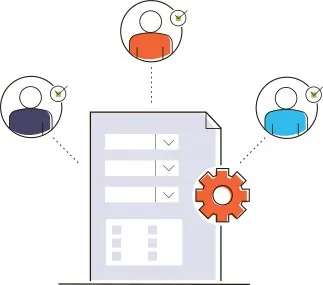Client Intake Process | Improving Onboarding Workflow
Table of contents

The client intake process (or "client onboarding process") is critical to ensuring smooth onboarding for client projects and ongoing success.
What is a "Client Intake Process?"
The intake process sets the foundation for the ongoing relationship between the client and the vendor. It is the critical step where client and project information is collected for use throughout a project lifecycle.
Unfortunately, many organizations still rely on a series of manual intake forms, emails, phone calls, spreadsheets, and file storage to manage customer/client intake despite the importance of having a consistent, standardized method.
Stages of the Client Intake Process
The client intake process is a crucial step in customer service that many businesses overlook. It’s the process of managing client inquiries and interactions after attracting a potential client. A well-structured client intake process can lead to increased client conversion rates, reduced time spent on non-billable tasks, and higher client satisfaction. By optimizing your client intake, you ensure that every potential client receives the attention and information they need right from the start.
Attracting Potential Clients
Attracting potential clients is the first stage of the client intake process. This involves creating a welcoming atmosphere and making it easy for potential clients to contact the business. A prospect intake form can be a useful tool, allowing clients to seamlessly enter their information and begin the process themselves. The form should ask for essential information, such as the client’s name, email address, and company website. By simplifying this initial step, you can ensure that prospective clients feel valued and understood from the very beginning.
Capturing Contact Information
Capturing contact information is the next stage of the client intake process. This involves collecting the client’s contact details, such as their phone number, address, and preferred method of communication. It’s essential to make sure the client understands and agrees to the terms outlined in the welcome packet. Clear communication at this stage helps build trust and sets the tone for a positive ongoing relationship. Ensuring that all contact details are accurately recorded and easily accessible will streamline future interactions and enhance overall client satisfaction.
What's the Risk of Poor Client Onboarding?
Bad client intake can be risky for companies that rely on solid client relationships and low client turnover to hit revenue goals. This is especially true of organizations that provide an opt-out clause or shorter contract lengths.
A bad client onboarding process can lead to the following:
- Contract opt-outs.
- Slow product/service uptake.
- Poor customer experience.
- Reduced upselling.
- Loss of product/service sponsorship.
Client Intake Form

The process usually begins with an intake form being completed either by the client or the vendor. The information may include the following:
- Client point of contact details
- Additional client contact information
- Executive sponsor
- Project description/executive summary
- Project start and end dates
- Deliverable confirmation
- Billing information
Sometimes, the client intake form may be completed directly by the client in an online portal. In other cases, a staff member at the vendor may be completing the form, in which case, additional internal information may be captured up front, including:
- Cost estimates
- Hours estimates
- Project type
- Project group
- Channel director
- Product owner
Intake Routing
Depending on the complexity of the client intake process and the size of the teams involved, there may be more to the routing of collected information than simply populating a CRM or ERP system. Additional reviews, intake forms, approvals, etc., may need to be deployed internally to ensure a smooth rollout. Customer Relationship Management (CRM) systems play a crucial role in intake routing by centralizing client information and automating the intake processes, thereby enhancing operational efficiency and client engagement.
How Do You Automate Client Intake?
Ensure your process for onboarding new customers meets your organization's needs. It delivers the customer satisfaction you expect to provide; the best approach is building a customized strategy. Nutrient Workflow offers a completely scalable and customizable platform for building forms, processes, and portals for client intake or any other workflow needs you have.
Interested in Automating Your New Client Workflow?
We have a library of resources to help you navigate an automated workplace.
- Workflow Tools and eBooks
- Workflow Ideas Weekly Email Newsletter
- Product Videos
- Request a Live Demonstration
FAQ
The client intake process is the step where client and project information is gathered to establish a solid foundation for successful collaboration throughout the project lifecycle.
A smooth onboarding process ensures better client retention, reduces errors, and improves the overall customer experience, leading to higher satisfaction and long-term success.
Automation streamlines data collection, reduces errors, and ensures a more efficient workflow, saving time and resources while providing a better client experience.
Poor client onboarding can lead to slow product/service uptake, contract opt-outs, poor customer experience, and missed opportunities for upselling.
A typical intake form includes details such as client contact information, project description, billing information, start/end dates, and deliverable confirmation.







